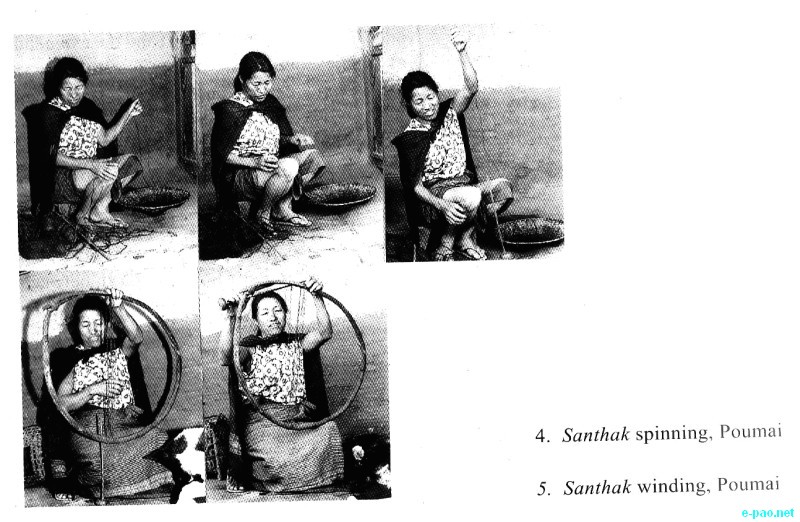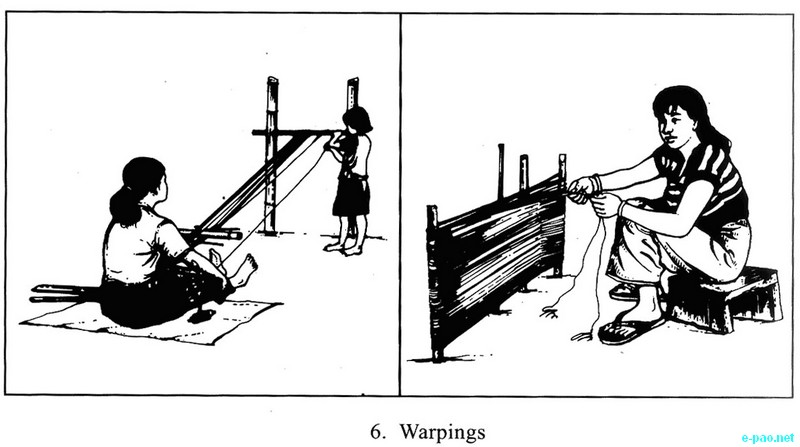Tribal hand woven fabrics of Manipur
- Part 3 -
By: Mutua Bahadur *
TOOLS, IMPLEMENTS & TECHNIQUE
There are different stages in which the tribal women of Manipur make yarn from natural fibrous materials. The stages are described below.
Ginning
The tribal weavers employ a wooden ginning machine to separate seeds from cotton. Two wooden posts measuring 36 cms. each are fixed vertically at a distance of 16 cm on a wooden plank. Two rollers are horizontally fixed a little below the top end of the posts. On one side, the ends of the two rollers are extended beyond the vertical post and the extended portions are carved in a Marei (crank design) so that these can be used effectively in the process of ginning.
On the other side, that is, to the other vertical post, a handle is attached at the level of the second roller. A flat wooden piece is also fixed horizontally below the two rollers. While manipulating the cotton gin, the space between the two rollers is adjusted. A wooden wedge is placed between the lower roller and the flat wooden piece for adjustment to get the "tightened" and "loose" operations.
A small wooden piece is also attached to the side of the flat wooden base. Placing the ginning machine in front of the ginner, she keeps one of her feet over the base extension and across the base so as to keep the gin firm on the ground during the operation period. While feeding cotton in between the two rollers, one hand convenient to the operator rotates the handle. In this way, the seeds are trapped while the cotton freed from the seeds fall on the other side of the gin. The treated cotton is then dried in the sun.
Carding
The treated cotton is put inside a basket which is known to the Meiteis as Lasing Kapon. The basket is 58 cm high and its mouth measures a diameter of 43 cm. An instrument known as Huitri is also used for combing the cotton fibre. Huitri is a bowlike equipment. The stave, which is made of bamboo, measures 80 cm in length and the bow string is made of cane. The carder places Lasing Kapon containing the cotton horizontally with its mouth facing her. The Huitri is put inside the basket. The stave is held by her left hand while the string is being twanged by the right hand. In doing so, the tufts of raw unspun cotton becomes cleaned as well as combed.
Spinning
The spinning of cotton is done easily by the right hand against the thigh. The cotton is spun by rubbing it against the thigh and this process is carried out with the help of a spindle weighted by spindle whorl.
In Santhak (Urtica sp.) spinning, the tribal weavers spin thread not only from cotton but also from the bark of some plants. The Mao, the Maram and the Poumai extract thread from the bark of Santhak (Urtica sp.). They gather the fibrous stuff which is then soaked in water. It is split into minute filaments. It is spun into fine strand twisting three filaments and spinning is done adopting spindle and spindle whorl technique. The spindle is made of cane and it measures about 38 cm. in length. Flat and circular stone spindle whorl is 2.8 cm thick and its circular surface has a diameter of 5.3 cm. The spindle and spindle whorl are collectively known as Lonjamah.

Winding
The spun thread is turned into Langkhai that is, a hank. This process is known as winding. For this, an instrument locally known as Tawot is employed. It has a bamboo shaft to which two small rods are pierced through near the terminal ends. While holding the shaft of Tawot in the middle by her left hand, she winds the strand of cotton using her other hand.
In case of Santhak thread, the winding implement is called Louhao. It is made of a branch of a tree which is bent into a circle and bound with creeper. The diameter of Louhao measures 6.3 cm. The spun thread is winded around Louhao to form a hank. The thread, together with pounded rice and leaves of Khagui plant, are put together in a pot containing water and then boiled. Thus prepared, the yarn is ready for weaving.
Twisting
Winding of cotton thread is followed by the stage of twisting. The required implements are Masa and Tareng, that is, spinning wheel. Masa is made of wood, bamboo, iron and thread. To a wooden rod having an iron spike on each end, bamboo strips are pierced through in such a manner that three bamboo strips are there on one end. The tips of the six bamboo strips are joined with a rope (made of thread) thereby forming a hexagonal shaped drum-like wheel.
It is put on a wooden stand. Tareng is also made of bamboo, cane, thread and wood. It has a wheel which is connected to the handle on one side while there is a bamboo spike on the other side. The cotton in hank is wrapped around the Masa. A bobbin is temporarily fixed to the spike of the Tareng and the thread from the Masa is connected. The thread from the Masa is wound around the bobbin when the wheel of the Tareng is operated by the right hand of the weaver.
Loom Production
The following is the technique of weaving in Khwang Iyong (Loin Loom). Prior to weaving, preparation is needed for fitting the warp in the loin loom. There are two methods for fitting the warp in the loin loom. In the first method, two persons are needed to fit the warp in the loom. A woman sits holding and tautening the loom by means of a Sanam (back-strap) connected to Yetpu Kanaibi (breast bar). She arranges the thread and gives the thread to the other woman who goes to wind the thread around the Yetpu front bar and comes back to give the end of the thread for the repeated operation by the first woman. In doing so, the Sunachei (heald bar), Utong (bamboo rod and lease rod) are also fixed in their proper places.
For the preparation of warp, two sets of threads are taken from the bobbins and are tightened to each other around the breast rod. Then, one thread passes below the circular bamboo bar but encircles the lease rod, after which the thread passes below it to the front bar, while the other thread which remains free from the heald passes over the circular bamboo bar but below the lease rod. These two strings are now handed over to the second woman who goes to encircle around the front bar and comes back and passes the thread to the first woman.
The whole process is repeated. Thus the warp is fitted in a circular fashion. The lower portion which does not pass through any instrument, remains inactive while weaving is done on the upper portion. This will also effect the woven portion to go down and the free portion to go up and pass through the same set of instruments like the above set as the whole thing is circular.
In the second method, only one woman is needed. Round rods made of bamboo or wood are fixed vertically on the ground. The woman goes up and down to prepare the warp in the loom. Facing north, she initiates the preparation of warp by taking two or two sets of thread which are tied to each other around the Yetpu Kanaibi rod. These two threads are called Nat and Tong. The Nat is adjusted to the heald for which two rods are posted closely to each other.
Then the Nat thread is carried below Utong and is passed to encircle the Nayetchei. After encircling the Nayetchei, it is passed below the Nayetchei to the Yetpu. The other thread, that is, Tong which is freed from Suna heald, is carried over the Utong and it is passed below Nayetchei. Then both the Nat and the Tong threads are put over the Yetpu and carried back freely below all the implements to restart and repeat the process. Instead of pinning on the ground, some tribes keep the rods horizontally by fastening to some available supports for the preparation of warp. Tribes in Churachandpur District adopt this method.
Some weavers do not post rods meant for heald at the time of preparation of warp. But heald adjustment is done when the warp has been filled and suspended. This technique is observed among the Mao.
Another way of preparation of warp by either one or two weavers is employment of only one thread or one set of thread. For it, the thread is wrapped separately twice — one for the Nat and the other for the Tong. In other words, in case of using two or two sets of thread, one is treated as Nat while the other is treated as Tong and these two (Nat and Tong) are used simultaneously. But in case of using only one or one set of thread, the same thread is used separately.
First, it is passed as Nat and is returned freely below the instruments and, secondly, it is again passed as Tong to be returned freely below the instruments. Then, this process is executed repeatedly.

Operation of Khwang Iyong (Loin Loom)
Various designs can be woven interlacing the warp in the loin loom. Fixing the back strap, the weaver sits with a loom; she keeps her legs against the foot rest and the latter can be adjusted from time to time for keeping the loom in tension. There are three main features in the technique of weaving in a loin loom. These are, namely, the shading motif, the picking motif and the beating motif.
With the left hand lifting up the Sunachei (heald bar), the right hand presses down the Utong (bamboo bar) simultaneously. Tern (sword) is kept vertically and the right hand passes the woof from the right side by means of the Pangaltem (shuttle) and the left hand picks it. With the Tern the weft is beaten. The Tern is then removed.
Producing the centre-shed, the left hand passes through it the shuttle and the right hand picks it up. The weft is again beaten with the help of Tern. The process is repeated. The bamboo splits work as the pass weft at the beginning of weaving. Then this technique of plain weaving, which provides one set of yarn up and one set down, is carried on.
See a gallery photo of Tribal hand woven fabrics of Manipur here.
To be continued ....
|
* Mutua Bahadur contributes to e-pao.net regularly. This article was webcasted on August 01, 2012.
* Comments posted by users in this discussion thread and other parts of this site are opinions of the individuals posting them (whose user ID is displayed alongside) and not the views of e-pao.net. We strongly recommend that users exercise responsibility, sensitivity and caution over language while writing your opinions which will be seen and read by other users. Please read a complete Guideline on using comments on this website.









